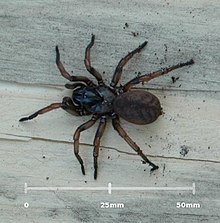| Stanwellia grisea | |
|---|---|

| |
| Scientific classification | |
| Domain: | Eukaryota |
| Kingdom: | Animalia |
| Phylum: | Arthropoda |
| Subphylum: | Chelicerata |
| Class: | Arachnida |
| Order: | Araneae |
| Infraorder: | Mygalomorphae |
| Family: | Pycnothelidae |
| Genus: | Stanwellia |
| Species: | S. grisea |
| Binomial name | |
| Stanwellia grisea (Hogg, 1901) | |
| Synonyms | |
| |
Stanwellia grisea, also known as the Melbourne trapdoor spider, is a species of mygalomorph spider in the Pycnothelidae family. It is endemic to Australia. It was described in 1901 by British arachnologist Henry Roughton Hogg.
Description
Female spiders grow up to 35 mm in body length; males to 25 mm. The body is brown; the abdomen may be paler with a darker, rib-like pattern on the upper surface. Large cheliceral fangs are displayed when the spider feels threatened.
Distribution and habitat
The spiders are found in southern Victoria in tall open forest habitats. Their range includes the environs of the city of Melbourne and the Grampian Mountains. The type locality is Macedon.
Behaviour
The spiders are fossorial, terrestrial predators. Both males and females dig individual silk-lined burrows, up to 40 cm deep in soft earth, with silk threads radiating from the entrances. They ambush insects and other small prey at night from the burrow entrances which, despite the common name, do not have trapdoors. During autumn and early winter, males leave their burrows and wander widely in search of mates.
Interactions with humans
The spiders, especially the roaming males, can be encountered in gardens and urban areas. Their fangs are capable of delivering a deep and painful bite, which may cause a local reaction.
References
- ^ Hogg, HR (1901). "On Australian and New Zealand spiders of the suborder Mygalomorphae". Proceedings of the Zoological Society of London. 1901 (2): 218–279 .
- ^ "Species Stanwellia grisea (Hogg, 1901)". Australian Faunal Directory. Dept of Climate Change, Energy, the Environment and Water, Australia. 2022. Retrieved 2023-06-25.
- ^ Ken Walker (2022). "Stanwellia grisea (Hogg, 1901), Melbourne Trapdoor Spider". Museums Victoria Collections. Museums Victoria. Retrieved 2023-06-25.
| Taxon identifiers | |
|---|---|
| Stanwellia grisea | |
This Pycnothelidae-related article is a stub. You can help Misplaced Pages by expanding it. |